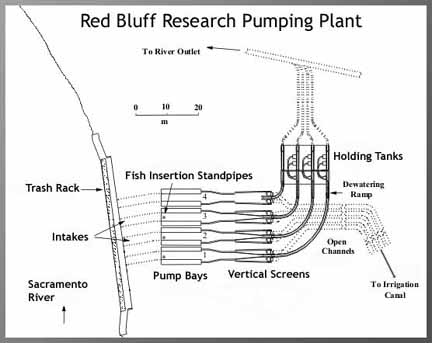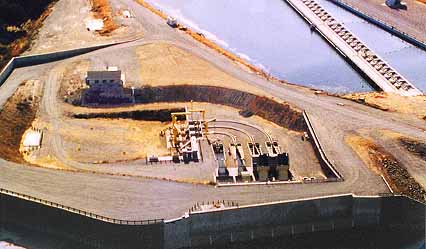- Reclamation
- California-Great Basin
- Programs & Activities
- TFFIP
- Technical Reports & Data Downloads
- Red Bluff Research Pumping Plant Program
Red Bluff Research Pumping Plant Program
Red Bluff Research Pumping Plant
Red Bluff Research Pumping Plant (RPP) is located along the Sacramento River at the Bureau of Reclamation's Operations and Maintenance Complex for Red Bluff Diversion Dam and the Tehama-Colusa Canal. The dam and pumping plant are located at river km 391 (river mile 243) above San Francisco Bay near Red Bluff, California. The pumping plant was constructed to test new fish-protection technology that involves two Archimedes lifts, one internal helical pump, and vertical wedge-wire screens and fish-bypass structures that are located on each pump's effluent-stream. The project is part of Reclamation's commitment to improve fish passage at the dam and to deliver water to the Tehama-Colusa Canal as needed during the eight-month gates-raised period.
Construction of the RPP took 18 months and was completed in 1995. Major features of the plant are shown in the schematic diagram. The plant has four pump bays. Bays 1 and 2 each contain an Archimedes lift, bay 3 contains a Hidrostal pump, and bay 4 is empty but available for future installation of a pump. Trash racks situated in the river in front of the pump intakes exclude large fish and debris from entering the plant. The trash racks have vertical bars spaced 5.1 cm (2 in) apart. The horizontal intake pipes for each bay are 1.22 m (48 in) in diameter and are open behind the trash racks.

Schematic of the Red Bluff Research Pumping Plant showing major features. Pump bays 1 and 2 contain Archimedes lifts. The internal helical pump is in bay 3. Bay 4 is empty. Dotted lines designate underground portions of the pump intakes, the pipes delivering irrigation water, and the fish bypasses.
The intake pipes for bays 1 and 2 open directly into the rotating barrels of the Archimedes lifts. These lifts, manufactured by Wheelebrator/CPC, consist of 11.5 m (38 ft) long, 3.0 m (10 ft) diameter rotating cylinders with three helical flights continuously welded along the length of the cylinder's inside walls. Each lift has a rotating, sealed inlet at its lower end allowing it to operate over a wide range of river elevations. These lifts operate at a relatively high rotational speed of 26.5 revolutions per minute (rpm), delivering water at an average rate of 2.4-2.5 m3/s (85 - 90 ft3/s). The lift in bay 2 is wired to a variable speed drive allowing it to operate at reduced speeds. The Hidrostal pump, manufactured by Wemco-Hidrostal, has an inlet diameter of 91 cm (36 in) and is the largest of its type ever constructed. It has asingle-vane impeller cast with a rotating conical shroud. It is also wired to the variable speed drive and can be operated between 250 and 350 rpm to deliver water at an average rate of 0.6 to 2.3 m3/s (22 and 83 ft3/s).

Aerial view of the Red Bluff Research Pumping Plant located on the Sacramento River near Red Bluff, California.
Each of the three pumps has its own screening facility, fish evaluation facility, and underground bypass. After passing through a pump, water and its contents are discharged into a concrete sluiceway. The sluiceway leads to a screening facility consisting of vertical wedge-wire screens (2.4 mm, 0.09 in openings) in a vee arrangement with continuously operating brushes. Approximately 90% of the pumped water passes through the screens to the canal while the remaining 10%, along with fish and debris, is diverted into a curved, open bypass channel. Flows in the bypass channel can be diverted into holding tanks in the fish evaluation facility, or returned to the river downstream of the diversion dam via underground conduits.
Red Bluff Research Pumping Plant Evaluation Program
The RPP included many features that were untested or had very limited documentation of their effectiveness. For example, neither Archimedes lifts or internal helical pumps, of the size and design installed at the RPP, had been evaluated for their ability to pass fish unharmed. Therefore, Reclamation committed to conduct a comprehensive, multi-year research program consisting of biological and engineering evaluations of the plant. Results of the research would be used to evaluate whether a future, large-scale pumping plant would be feasible for meeting the water delivery needs of the Tehama-Colusa and Corning canals in a manner that would protect fishery resources.
Prior to construction of the RPP, an interagency team of fishery biologists and engineers was assembled to develop a plan for the bioengineering evaluations at the plant. Study goals and specific objectives were identified for evaluations of the pumps, screening facilities and fish bypasses (Table 1). Biological evaluations focused on downstream migrating juvenile salmonids and associated predators in the Sacramento River, primarily Sacramento pikeminnow Ptychocheilus grandis and striped bass Morone saxitilis. In-river studies included evaluations of distributions and movements of adult and juvenile salmonids, as well as their predators, in the vicinity of the plant. In-plant studies included assessing diel and seasonal patterns of fish entrainment from the Sacramento River, and mortality, injury, and stress of hatchery-reared juvenile Chinook salmon passed through the pumps. Engineering studies included performance characteristics of the trash racks at the pump intakes and of the pumps, and hydraulic evaluations within the screening facility.
As of February, 2003, results from all but two of the studies undertaken have been reported in a volume of the Red Bluff Research Pumping Plant report series. There are currently 14 volumes in the report series. Click here to view abstracts or download Adobe Acrobat PDF files for these reports.
| Goals | Research Objectives |
|---|---|
| Determine if the pumping plant can operate with minimal loss or harm to downstream migrating Chinook salmon young. | A1 Assess mortality and injury to young Chinook passing through the drum screen bypass at Red Bluff Diversion Dam (terminus for the pumping plant bypass) under conditions that reflect seasonal and flow rate changes. |
| B Assess mortality and injury to young Chinook subjected to passage through Archimedes and internal helical pumps under environmental conditions typical of wet and dry seasons of the year. | |
| C Obtain 100% recovery of juvenile Chinook salmon entrained from the Sacramento River in holding tanks on fish bypasses in the pumping plant. | |
| D Assess mortality and injury to young Chinook subjected to passage through pump outfalls, screening facilities, aboveground bypass channels and holding tanks in the plant under environmental conditions typical of wet and dry seasons of the year. | |
| E Obtain residence time and assess mortality and injury to young Chinook subjected to passage through the below-ground bypass from the pumping plant to the Sacramento River using the low bypass discharge expected with normal operation of the pumping plant and using higher pulsed flows that may be required to move fish to the bypass outlet. | |
| F Describe movements and behavior of young Chinook salmon in the vicinity of the plant's trash racks and pump intake structures using underwater video cameras and hydroacoustics. | |
| G Assess predator-prey interactions between young Chinook and Sacramento pikeminnow following passage of young Chinook through experimental pumps. | |
| H1 Develop an understanding of the seasonal and diel distribution and abundance of out-migrating juvenile Chinook salmon in the Sacramento River near Red Bluff Diversion Dam. | |
| I Estimate seasonal numbers, annual numbers, condition, and viability of juvenile Chinook salmon and other fish that are entrained from the Sacramento River and pass through pumps in the plant. Estimate seasonal and annual percentages of out-migrating juveniles that the plant entrains. | |
| Determine if the pumping plant can be constructed and operated in a manner that creates no new attraction for fish predators and, where possible, minimizes fish predation near structures of the plant. | J1 Assess seasonal adult pikeminnow movements and behavior near the pumping plant using radio-tracking techniques. |
| K1 Estimate seasonal abundance of fish predators near the trash racks, pump intakes and bypass outfall of | |
| L Assess predator colonization of the intake sump portion of the plant, and if predators reside in this area, develop methods to remove them. | |
| Determine if the pumping plant can be operated with no deleterious effects on upstream spawning migrations of runs of Chinook salmon and steelhead trout. | M1 Assess seasonal and diel movements of upstream migrating Chinook salmon and steelhead trout near the plant while it's operating using radio-tracking techniques, and if operations modify behavior in a negative way, recommend operational or structural changes for the plant. |
| Determine if the pumping plant can be operated with no harm to native Sacramento River fish populations from entrainment of their larvae. | N1 Estimate levels of annual entrainment of larval and post-larval fishes by the pumping plant, and assess the impact of entrainment on their populations. |
| Provide a record of environmental and engineering data for researchers to use to interpret data obtained from fisheries studies. | O Record water temperature, dissolved oxygen, pH, conductivity, turbidity, suspended solids, river stage and discharge, near the intake area of the plant through the duration of evaluation studies. |
| P Record air temperature, precipitation, barometric pressure, wind direction, wind velocity and solar irradiance at the pumping plant through the duration of evaluation studies. |
1 Work on these objectives was conducted by personnel from the U. S. Fish and Wildlife Service, Red Bluff Fish and Wildlife Office, Red Bluff, California. Work on unmarked objectives was conducted by U. S. Bureau of Reclamation personnel from the Red Bluff Field Office of the Northern California Area Office, and from the Technical Service Center, Denver, Colorado.
Note: Documents in Portable Document Format (PDF) require Adobe Acrobat Reader 5.0 or higher to view, download Adobe Acrobat Reader
By Charles Liston, Ph.D.
Former Red Bluff Research Program Director

